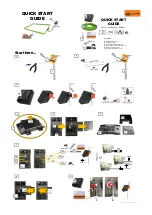
EVM Basic Functions
1-3
EVM Overview
1.2.2
Reference Voltage
The 5-V precision voltage reference is provided to supply the external voltage
reference for the DAC through REF02, U3, via jumper W4 by shorting pins 1
and 2. The reference voltage goes through an adjustable 100 k
Ω
potentiometer, R11, in series with 20 k
Ω
, R10, to allow the user to adjust the
reference voltage to its desired settings. The voltage reference is then
buffered through U8A as seen by the device under test. The test points TP1,
TP2 and TP5 are also provided, as well as J4- 18 and J4- 20, to allow the user
to connect other external reference source if the onboard reference circuit is
not desired. The external voltage reference should not exceed 5-V dc.
The REF02 precision reference is powered by V
CC
(15 V) through J1 - 3 or
J6 - 1 terminal.
Caution
When applying an external voltage reference through TP1 or J4- 20,
make sure that it does not exceed 5 V maximum. Otherwise, this
can permanently damage the DAC8574, U1, device under test.
1.3
EVM Basic Functions
The DAC8574 EVM is designed primarily as a functional evaluation platform
to test certain functional characteristics of the DAC8574 DAC. Functional
evaluation of the DAC device can be accomplished with the use of any
microprocessor, TI DSP, or some sort of a waveform generator.
The headers J2 and P2 are the connectors provided to allow the control signals
and data required to interface a host processor or waveform generator to the
DAC8574 EVM using a custom built cable.
A specific adapter interface card is also available for most of TI’s DSP starter
kit (DSK) and the card model depend on the type of the TI DSP starter kit to
be used. Make sure to specify the DSP that is used to interface with to acquire
the right adapter interface card. In addition, there is also an MSP430 based
platform (HPA449) that uses the MSP430F449 microprocessor, which this
EVM can connect to and interface with. For more details or information
regarding the adapter interface card or the HPA449 platform, please call Texas
Instruments Inc. or email us at
.
The DAC outputs can be monitored through the selected pins of J4 header
connector. All the outputs can be switched through their respective jumpers
W2, W11, W12 and W13, for the reason of stacking. Stacking allows a total of
eight DAC channels to be used provided that the I
2
C address is unique for
each EVM board stacked.
In addition, the option of selecting one DAC output that can be fed to the
noninverting side of the output op-amp, U2, is also possible by using a jumper
across the selected pins of J4. The output op-amp, U2, must first be configured
correctly for the desired waveform characteristic, refer to Section 3 of this
user’s guide.
Содержание DAC8574
Страница 1: ...DAC8574 Evaluation Module June 2003 Data Acquisition Digital Analog Converters User s Guide SLAU109 ...
Страница 17: ...PCB Layout 2 5 PCB Design and Performance Figure 2 7 Drill Drawing ...
Страница 19: ...EVM Performance 2 7 PCB Design and Performance Figure 2 9 INL and DNL Characterization Graph of DAC A ...
Страница 20: ...EVM Performance 2 8 Figure 2 10 INL and DNL Characterization Graph of DAC B ...
Страница 21: ...EVM Performance 2 9 PCB Design and Performance Figure 2 11 INL and DNL Characterization Graph of DAC C ...
Страница 22: ...EVM Performance 2 10 Figure 2 12 INL and DNL Characterization Graph of DAC D ...
Страница 24: ...2 12 ...












































